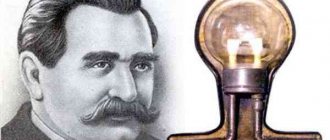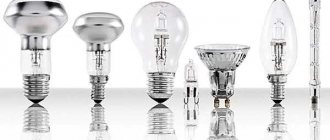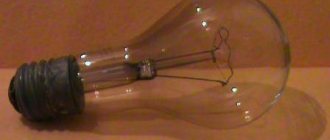Thomas Edison - the engine of progress
The 19th century is truly the century of scientific discoveries, giving birth to many great inventors. One of them was the American Thomas Edison, known primarily for the creation of the modern incandescent light bulb.
Before the spread of electric lighting, dim oil or kerosene lamps or overly expensive gas lamps were in use. Knowing these shortcomings, scientists around the world, even before Edison, struggled to create a lamp that would run on electricity. But it was impossible to come up with a well-functioning light bulb.
Edison was a terribly stubborn man. In search of ideal materials for a light bulb, he conducted several thousand (!) experiments. And in the end he succeeded. And most importantly, he launched the light bulb into mass production. The enterprising Edison and his partners founded a company for the production of cheap lamps, and also built a power plant and provided lighting for several blocks in New York (USA). Gradually the whole world switched to incandescent lamps.
The creation of the light bulb was preceded by thousands of unsuccessful experiments. However, Edison did not give up!
Everything down to the light. About the past and future of incandescent lamps
Replica of Thomas Edison's light bulb. Photo: NPS In 1881, the Electric Exhibition was held in Paris, where everyone who made them presented their light bulbs, from Edison and Swan to the British Hiram Maxim (the same one who invented the machine gun). Apparently, it was difficult to choose between them, since all the bulbs were already quite similar to each other.
The light bulb acquired its modern appearance—a tungsten filament in the form of a double spring, a smooth bulb without the typical 19th-century “pimples” on top, and a standard base—after the 1920s. By this time, they had come up with an economical way to make thin tungsten wire and decided that it was better to pump the air out of the flask from the opposite side. Edison developed the standard threaded connection for light bulbs back in 1909.
Shines and warms
If you approach an ordinary incandescent lamp strictly and boringly, then it is not a lighting device, but a heating device: the lamp produces only 5% of the energy consumed in the form of light, the rest goes into heat. And “heating” a room with light bulbs, if it is not an aquarium with a turtle, is quite expensive.
Saving energy on light bulbs is not only good for your wallet, but also for the Earth's climate, which is changing due to human activity. That's why major light bulb manufacturers, along with environmental activists and even national governments, have united in the Global Lighting Challenge - a global campaign to replace 10 billion light bulbs with LEDs. So far, “only” 187.5 million have been replaced, and if you wish, you can “register” your chandeliers or lamps in the entrance through the website.
In addition, incandescent light bulbs are short-lived: their standard lifespan is now about 1,000 hours, compared to several tens of thousands of hours for competitors - fluorescent and LED lamps. There is a whole story on this topic about the Phoebus cartel, which united the largest light bulb manufacturers around the world in the 1920s and 1930s: it is believed that it was there that they first came up with the idea of deliberately making their products short-lived in order to ensure constant demand for them.
The global campaign against incandescent light bulbs began already in this century and in 17 years has covered all of North America and almost all of South America, Europe, China, India, Australia and South Africa. Our country is still somewhat behind others in its determination, but is moving in the same direction. In the summer of 2021, the Russian Ministry of Energy proposed to ban the circulation of 60- and 75-watt light bulbs in the country (recall that the ban on 100-watt light bulbs has been in effect in Russia since 2011). According to the Ministry of Energy, in 2014, Russians bought about 168 million of these bulbs, compared to 110 million of modern LED bulbs. The ministry promises to return to this idea in February-March of this year.
While the Russian Ministry of Energy is discussing whether it is time to tighten the ring around inefficient lamps, the United States is acting more decisively. In May last year, the national Ministry of Energy proposed switching exclusively to LED lighting after 2020, abandoning not only the old incandescent lamps, but also fluorescent “spirals”. Ordinary American consumers did not like the latter so much that General Electric even closed their production in the States.
What changed with the invention of the light bulb?
- The streets began to be better lit. Oil, kerosene and even gas lamps were inferior in power to electric ones, and the dark streets of that time were infested with criminals. Brighter electric lighting made the streets calmer and safer.
- The daily routine has changed . Due to the poor lighting of houses, our ancestors went to bed early, almost at sunset. And they got up, on the contrary, at sunrise, adjusting to the daylight hours. With the advent of electric lighting, this changed. Now anyone could arrange their day as it suits them. Need to work at night? Easily! Do you want to go out for a walk or visit in the evening? Why not! Our current daily routine is a direct influence of electricity.
- It has become safer . Candles and gas lamps often caused fires. The spread of electric lighting has significantly reduced this problem.
Development of the horizons of children 6-13 years old
Do you want to know more interesting facts about outstanding scientists and their discoveries? We are waiting for you and your child at our online course “Cultural Code” for children 6-13 years old
find out more
Operating rules.
Do not forget the safety rules when using lamps:
- For connection it is necessary to use only certified cartridges.
- Light sources should only be inserted and turned out when they are cold: you won’t burn your hands and the light will shine longer.
- The life of light bulbs can be extended by reducing the number of on-off cycles.
- When using a dump in a portable lamp, move it from place to place only when it is turned off.
Thus, vintage Edison lamps came back into fashion. They have many advantages: ease of connection, soft, pleasant light, interesting design. Lamps will help create a cozy and stylish interior. Don't be afraid to experiment!
- Related Posts
- Why are chokes (ballasts) needed for fluorescent lamps?
- How does an LED lamp work?
- Which lamp to choose for plants - the best options
What else did Edison invent?
Edison did not stop at just the incandescent lamp. He made major contributions to the scientific discoveries of the 19th century. During his life, he patented more than 1,000 inventions. Strictly speaking, not all of them were exclusively his inventions - he simply refined and improved many of them. But his incredible productivity undoubtedly influenced the development of technology.
Here are 4 more of his developments:
- The phonograph is the first device for recording and reproducing sound. The demonstration of this device caused great enthusiasm from the public, and Edison himself was amazed by it. The inventor began to be called nothing less than a “wizard.” The very first phonograph recording has not survived, but you can listen to a slightly later recording from 1878. A simple melody can be heard in it, and then someone’s voice sings children’s songs. It's amazing what a step forward sound recording has made compared to the 19th century!
- The telegraph , a device for transmitting signals over long distances, was created long before Edison. However, the inventor made message transmission faster and easier. In general, the use of the telegraph made it possible to transmit information, including news, at high speed, making it easier to organize work at a distance. Essentially, it is the predecessor of the Internet.
- Telephone . Edison improved Alexander Bell's great invention by adding a microphone to it. Bell's telephone could transmit messages from one room to another, and Edison's invention made it possible to communicate over long distances, and the sound became louder. And it was Edison who came up with the idea of starting a conversation with the word “hello.”
- Kinetograph and kinetoscope are devices for recording and displaying moving pictures. These Edison devices were imperfect and were not widely used. But on their basis, the Lumiere brothers created their famous cinematography, which marked the beginning of the era of cinema.
Thomas Edison and his inventions
How a learning disabled boy, Thomas Edison, grew up to invent the light bulb.
When the light goes out in our homes today for even an hour, we immediately feel incredibly helpless. Sitting in the dark and unable to do anything interesting, we waste this time uselessly. And even though emergency services usually quickly fix all problems, for a couple of hours we can’t help but wonder what it was like for people before the invention of light bulbs. Meanwhile, we owe their appearance to a man whom the school considered hopeless and even refused to give him an education. The man who made 6,000 attempts to find the right filament material. You can read about how the first light bulb appeared and why, due to it, we often don’t get enough sleep, you can read in our article.
How mother's love helped nurture talent
Little Thomas Edison was kicked out of elementary school. And not because of bad behavior, but because the teachers considered him incapable of learning in principle. It is difficult to imagine what a blow was dealt to the child’s pride, but to the credit of his mother, she not only inspired her son that he had outstanding abilities that an ordinary teacher was simply unable to develop, so everything was for the better. Moreover, she herself took up the education of her beloved son and succeeded in this. By the way, she was also a former teacher, but she was able to discern a talent in her child that was not yet discovered by anyone else.
From his earliest years, Edison was distinguished by a special thirst for knowledge and perseverance in exploring the world around him.
Young talent
Edison had a flexible, inquisitive mind and already at the age of ten he was actively conducting his own experiments, albeit in the basement of his parents’ house, so as not to cause irreparable damage to the living quarters. When the equipment he had became insufficient, Thomas, smart beyond his years (he was already 12), decided to earn money on his own by actively selling newspapers and sweets on trains. Later, using the accumulated funds, the young talent bought a printing press and began publishing his own newspaper. Having increased the circulation to 400 copies, Thomas received a good income from the sale of his news sheet and finally saved enough money to continue his research in science.
Improvement Wizard
It is worth noting that Edison was especially good at always modernizing inventions created by other people and bringing them to perfection. So, working at the telegraph office at the age of 21, Thomas managed to change its structure for the better. Even in everyday matters, he approached everything from a scientific and practical point of view. Friends, coming to visit him and having difficulty opening the gate, unwittingly served a good purpose: they helped Edison pump up as many as 20 liters of water using a pump connected to the gate.
Still about the light bulb
The paradox is that Edison's most famous invention - the incandescent electric lamp - is not fully such. For the first time such a lamp was announced to the world by the Englishman Warren de la Rue: he placed a platinum wire inside a glass vessel and passed a current through it. Further modifications of this device followed, created by the Belgian Jobard, the German Gebel, the Englishman Swann and our compatriot Lodygin. By the way, it was the latter who created a lamp with a rod made of retort coal, and Edison replaced it with a hair made of charred bamboo fiber.
Lodygin's lamp
But one should not assume that this choice of material for the filament was easy for the scientist. Edison, being a fanatically purposeful person, once spent about 45 hours without sleep or the slightest rest in his laboratory, testing the characteristics of the carbon circuit of a lamp. And to choose the appropriate option for an incandescent lamp, the tireless enthusiast made as many as 6,000 attempts. As a result, the Japanese bamboo chosen by the scientist allowed the filament to emit light for many weeks without burning out. And it was Edison who brought together the lamp, the electric generator, the socket and the plug.
Thanks to his invention, people gained the opportunity to spend their leisure time in the evening no longer by candlelight, sleep less and get more done. Before the advent of Edison's lamp, people often slept about 10 hours a day, a luxury today perhaps only available to small children. So, perhaps, the only correct way out when the lights go out in the house is to really go to bed and spend these couple of hours ineffectively, but very pleasantly - in sweet dreams. The same way people did before the advent of lighting in every home.
What is worth knowing about Edison?
- Edison's biography is full of interesting facts. For example, he patented his first invention - an electric voting device - when he was only 22 years old!
- Edison’s efficiency can only be envied: until he was 50, he worked 19 hours a day.
- Despite his outstanding talents, Edison had a bad character. His quarrel with Nikola Tesla, whom Edison deceived and left without a fee, is well known. Tesla immediately left Edison's laboratory and began his equally brilliant inventive career.
- Edison may have been the first "video pirate" in history. He reproduced the film “A Trip to the Moon” and began selling it. And he explained this by the fact that he received a patent for film with perforation, on which the film was shot. What a tricky one!
Interesting, isn't it? This is how inventions made in the distant 19th century changed our lives. It also proves that it’s rare for one person to just sit down and invent something from scratch. Scientific discoveries and inventions are always a process extended over time. That's why it's so important to know their history.
The online course “Great Scientific Discoveries” helps children aged 6–13 years old to immerse themselves in this fascinating topic. There is a theory, interesting tasks, and a verification test to consolidate the result. As part of the course, the child will get acquainted with other, no less exciting, stories from the world of science and learn about outstanding scientists and inventors whose discoveries we actively use today.
Physics courses for children 7-14 years old
We teach physics and natural sciences in a fun game format.
Short courses are adapted for the perception and enjoyment of children find out more
Edison decorative lamps
The Edison lamp in the interior not only performs its direct function, but also helps to create interiors in loft, minimalism, steampunk, Bauhaus, and contemporary styles. It resembles the design that was presented by the American inventor, but has acquired new features:
- The glass flask has various shapes and sizes.
- The number of tungsten filaments in it can reach 20. This is done for brightness of lighting and impressive appearance.
- The luminous threads inside the bulb are arranged in intricate ways, creating various shapes.











